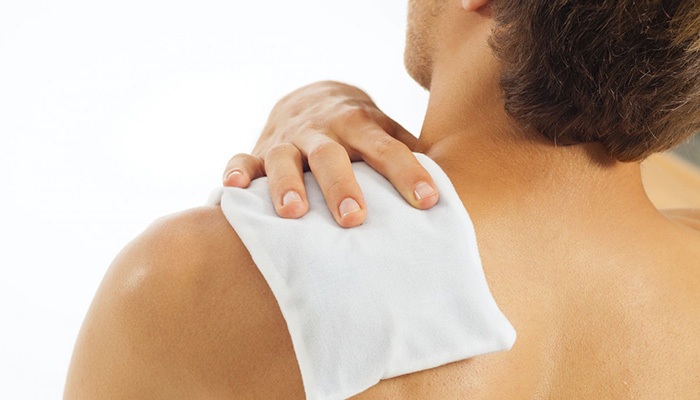
Whether you run a marathon or go for a trek, you come back with some amount of soreness of the muscles. There’s a possibility of soreness even after a strenuous gym workout. When some of my players experience minor aches and pains, I often tell them to “drink lots of water and stretch“. Apart from drinking water and stretching, there are 2 routes which are commonly used for pain relief:
- Cryotherapy or Ice therapy
- Thermotherapy or Heat therapy
Which therapy you use, depends on the situation and the kind of pain/injury. Let’s go over some markers which might be useful to you.
Ice Therapy: What Happens When You Do It?
Our body has skin receptors which pick up different sensations that include touch, pressure, pain and temperature. If you look in to these skin receptors, you will find out that the body has more cold receptors than heat receptors.
When you use ice therapy or apply ice, your skin activates the cold receptors and they block the sensation of pain. After an injury, the area might be red and swollen. Applying ice will help in reducing or preventing the inflammatory response. Ice causes vasoconstriction (narrowing of blood vessels) which reduces blood flow temporarily.
How Do You Use It?
- Ice packs (frozen packets): These are the best and most portable option as it will adapt and mold to the body part accordingly
- Ice in a towel: You can also hold ice in a towel and apply it on the injury. The towel will provide additional compression
- Using a light cloth: If you have sensitive skin, keep a barrier between the skin and ice. A thin cloth or light cotton one can help
When Should You Use Ice Therapy
You can use ice therapy under the scenarios mentioned below:
1. If the injury is sudden and acute: Ice therapy will help in preventing swelling and will provide relief from the pain by reducing the blood flow to that area.
For example: If you sprain your ankle during a marathon, trekking or while working out in the gym, apply a pack of ice to reduce the swelling. The sooner you apply the ice, the better.
2. Soft tissue injuries: Applying ice after a strenuous workout will help in relieving the muscle soreness and aid the recovery process.
Try using ice therapy 4 times a day for 2 days. If the pain persists, you should visit your doctor or physiotherapist.
When Should You Avoid Using Ice Therapy?
“Ice is good, but not always!” Below are scenarios where ice therapy might make your situation worse.
- Avoid applying ice on open wounds
- If you are a high B.P patient, avoid ice therapy on the shoulder and near the neck region. It will raise the systolic and diastolic pressure because of decrease in blood flow
- Do not apply ice before a workout but if your workout consist of stretches, then apply ice for healing the acute injury
- If you have issues with blood circulation
- If you have stiff joints, applying ice will increase the stiffness
- If the pain becomes chronic i.e. more than 72 hours, it is not a good option as now ice is not needed to stop the blood flow
- If you have a persistent lower back pain, ice therapy won’t work.
How Long Should You Continue With Ice Therapy?
You need to be careful about the icing duration as excess of icing might cause pain due to lack of blood flow. If you have sensitive skin, applying ice directly to the skin might not be a good option.
- For a minor post workout injury, 15min is the most optimal time
- To deal with acute soft tissue injury, 10min session is optimal
- Deeper the injury, longer the icing time. For example, hamstring injury might need longer icing time then an injury on the finger
Heat Therapy: What Happens When You Do It?
Like Ice therapy, heat therapy is also used for relieving pain and aids the healing process. When you apply heat to the injury, unlike ice therapy which first causes vasoconstriction and then vasodilation, heat therapy directly causes vasodilation which increases the blood flow to the injured part.
How Do You Use It?
- Whole body heat therapy: This includes steam, sauna or a jacuzzi which can be used to relax your entire body
- Heat packs: Applying a heat pack without direct contact to the injured part is a great way to aid the healing process.
When Should You Use Heat Therapy?
- You can use heat therapy for chronic pain. After 72 hours, once the injury has crossed the acute stage and the inflammation is reduced, heat can be giving to aid the healing process.
- Heating can reduce your stiffness as well because it increases the blood flow to the stiff part making it more flexible.
When Should You Avoid Heat Therapy?
- Do not apply heat to a fresh injury. This can cause increase of blood flow which can increase the inflammation.
- Never apply heat to the places where it is swollen. Only ice should be used till the swelling reduces.
How Long Should You Continue With Heat Therapy?
- 18-20 mins is the most optimal time for a heat therapy session. Please note that this doesn’t remain the same for all as it entirely depends on the type of heating method used.
- It is advisable to keep a barrier between the skin and the heat pack to avoid direct contact and feel a burning sensation.
- Comfort level is very important in heat therapy sessions. You should get optimal heat, excess of it might make you uncomfortable.
These are the basics about Ice and Heat therapy. It should help anyone who is working out or running a marathon or goes for a trek very often. So, the next time before reaching out to any painkillers or pain relief ointments, reach out to the things mentioned in this article! But if you are not sure about your injury, it is always better to speak with your coach, doctor or any physiotherapist.
If this article helped you, let us know your thoughts in the comments below. Find more articles on fitness here.
Still not sure whether you should use ice therapy or heat therapy? Speak to one of our experts by subscribing to GOQii’s Personalised Health Coaching here.
#BeTheForce

 The onset of the cool, rainy weather calls for a bowl of piping hot soup! If you\’re keen on experimenting with some new recipes, why not try this delicious bowl of Chilli Bean Soup? It\’s easy to prepare and is totally nutritious! Let\’s get started.
The onset of the cool, rainy weather calls for a bowl of piping hot soup! If you\’re keen on experimenting with some new recipes, why not try this delicious bowl of Chilli Bean Soup? It\’s easy to prepare and is totally nutritious! Let\’s get started.



